|
The House of Este in Ferrara, Modena and Reggio Emilia
back to Part 1 Niccolò III d'Este, reigned 1393-1441 Leonello d'Este, reigned 1441-1450 Borso d'Este, reigned 1450-1471 Ercole (Hercules) I d'Este, reigned 1471-1505 Ercole's daughter : Isabella d'Este (1474-1539) back to Part 2
here Part 3
|
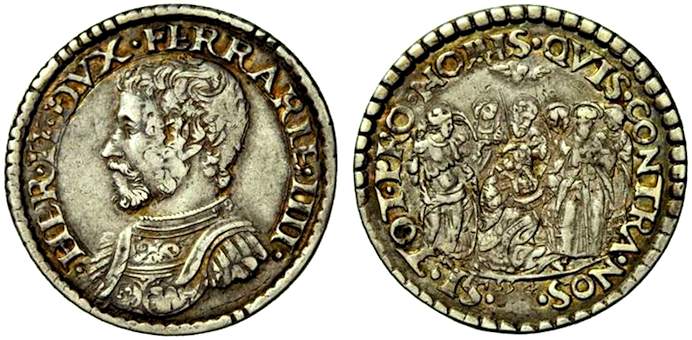
Testone (Quarto scudo) 1534, Ferrara. Ø 29 mm, 9,62 g. CNI X 455/8; RM 156/4. Obv.: HER·II·DVX·FERRARIE·IIII· - armored effigy left. Rev.: SI·TOT·PRO·NOBIS·QVIS·CONTRA·NOS "If many are for us, who can be against us?" Mary with child surrounded by saints, above the Holy Spirit, below the date 1534.
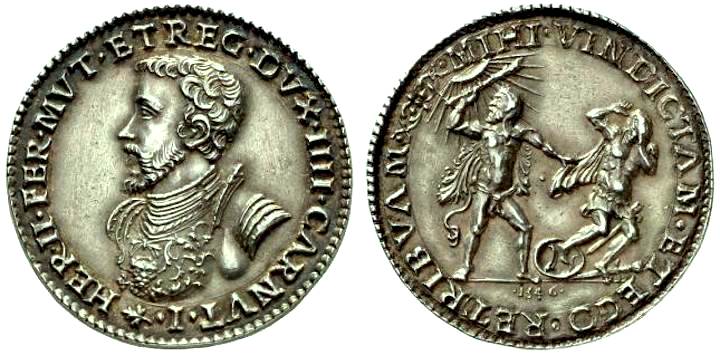
1/2 Scudo 1546, Ferrara. Ø 35 mm, 17,44 g. CNI X 455/13; RM 155/3. Obv.: +HERcules·II·FERrariae·MVTinae·ET REGii·DVX·IIII·CARNVTum·I· "Herkules II, 4th Duke of Ferrara, Modena and Reggio and 1st of Carnutum" [Carnutum = Chatres] (The newly created Duchy of Chatres was a dowry of his wife Renée in 1528.) Armed effigy to the left, dies attributed Bartolomeo Nigrisoli. Rev.: ·MIHI·VINDICTAM·ET EGO·RETRIBVAM· "Vengeance is mine, I will repay" (... says the Lord = Romans 12:19) Hercules in the lion's skin directs the view to the sun, while with the left he holds a warrior who has thrown his weapons to the ground. Exergue: date 1546.
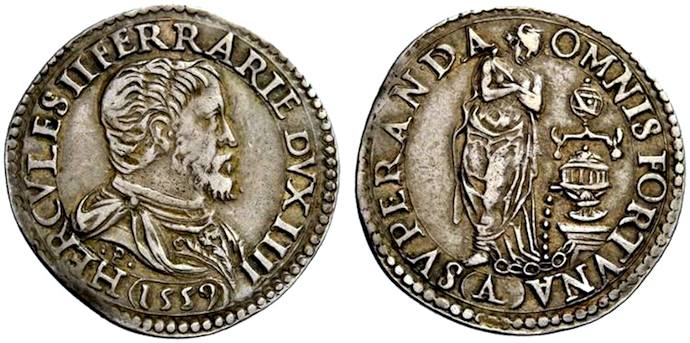
Testone (Quarto scudo) 1559, Ferrara. Ø 29 mm, 8,62 g. CNI X 456/16; RM 157/6. Obv.: HERCVLES II FERRARIE DVX IIII - effigy with draped harness to the right. On the shoulder · P · (pastorino, engraver), at the bottom 1559 in cartouche. Rev.: SVPERANDA - OMNIS FORTVNA ferendo est "every misfortune is to be subdued by patience" (Virgil) Patientia chained to a pedestal at the foot; on the pedestal a container or water clock; from this, water drips on the chain until it breaks. Below an A in a cartridge. Legend and figure of the reverse form together a so-called "Impresa".
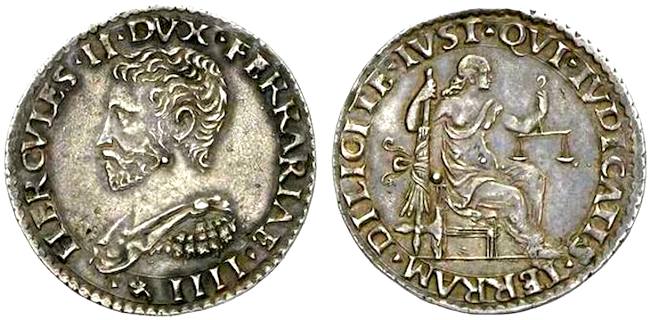
Bianco (10 soldi) n. d., Ferrara. Ø 25 mm, 4,94 g. CNI X 461/56; RM 159/10. Obv.: HERCVLES·II·DVX·FERRARIAE·IIII· - armored bust to the left. Rev.: DILIGITE·IVSTitiam·QVI·IVDICATIS·TERRAM· "You who judge the world love justice!" Sitting Justitia with halberd and scale. This is one of the first coins issued in the value of 10 soldi.
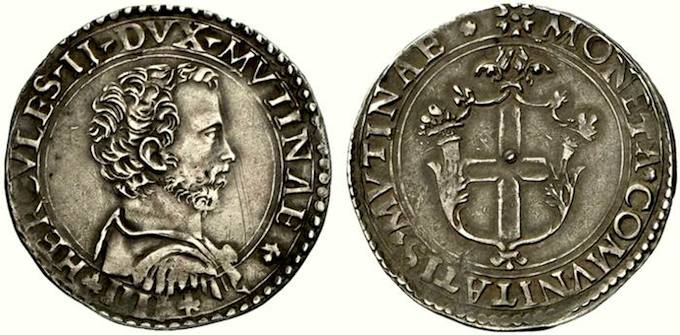
Bianco (10 Soldi) n. d., Modena. Ø 28 mm, 4,92 g. CNI IX 209/56; RM 163/19. Obv.: HERCVLES·II·DVX·MVTINAE·IIII· - effigy in armor to the right. Rev.: ✿MONETA·COMVNITATIS·MVTINAE· - arms of Modena (blue cross on golden field).
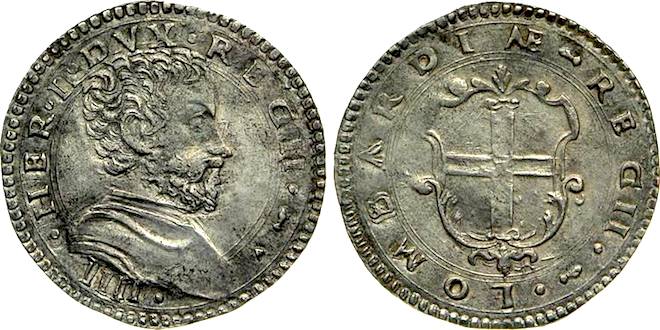
Bianco, Reggio Emilia. Ø 29 mm, 4,98 g. CNI IX 709/169 (tav.43/4-5); RM 165/24var; MIR 1306. Obv.: ·HER·II·DVX·REGII·ᕠ· - ·IIII - bearded bust to the right. Rev.: ᕠREGII·ᕠ·LOMBΛRDIΛE - arms of Reggio Emilia (red cross on white field)
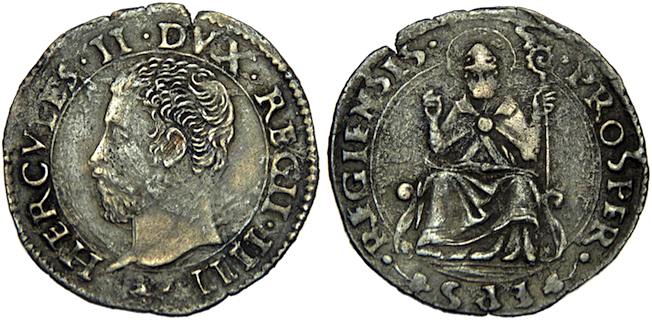
Giulio, Reggio Emilia. Ø 25 mm, 2,80 g. single known specimen; RM -. Obv.: HERCVLES·II·DVX·REGII·IIII· - head left. Rev.: S - ·PROSPER· ᕠ EPS ᕠ ·REGIENSIS· Seated saint from the front, raised right hand, crook in the left hand.
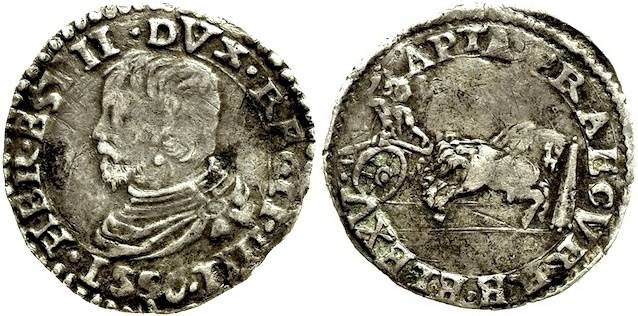
Cavallotto 1550, Reggio Emilia. Ø 24 mm, 2,87 g. CNI IX 697/88; RM 169/33. Obv.: HER·EST·II·DVX·REGII·IIII·1550· - effigy with draped harness to the left. Rev.: ·APTA·PRAECVRRE·FLEXV· - Roman directs Quadriga to a pyramid-shaped target. The Quadriga, symbol of victory, is suitable to reach the goal.
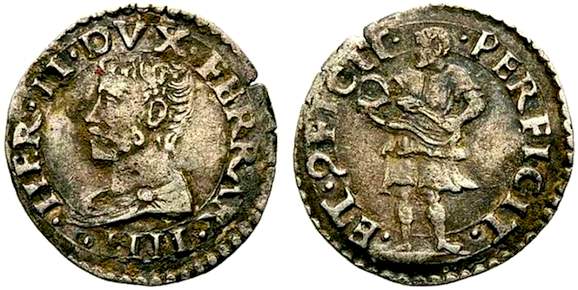
Grossetto n. d., Ferrara. Ø 19 mm, 1,35 g. CNI X 463/77 tav.31/19; RM 161/14. Obv.: ·HER·II·DVX·FERRAR·IIII· - draped bust left. Rev.: ·PERFICIT· - ·ET·9FICIT· Perficit et Conficit Saturn in Egyptian clothes from the front. He holds a snake biting into the tail.
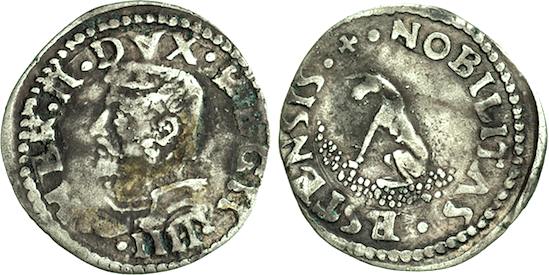
Grossetto n. d., Reggio. Ø 17,7 mm, 0,95 g. CNI IX 718/256; RM 171/38; MIR 1322. Here in silver, otherwise in copper ("mistura") as sesino. Obv.: ·HER·II·DVX·REGII·IIII· - armored bust left. Rev.: +·NOBILITAS·ESTENSIS· - sitting unicorn to the left. The fabled unicorn stands for generosity, steadfastness, honest love.
It is also found in several places in the city of Ferrara.
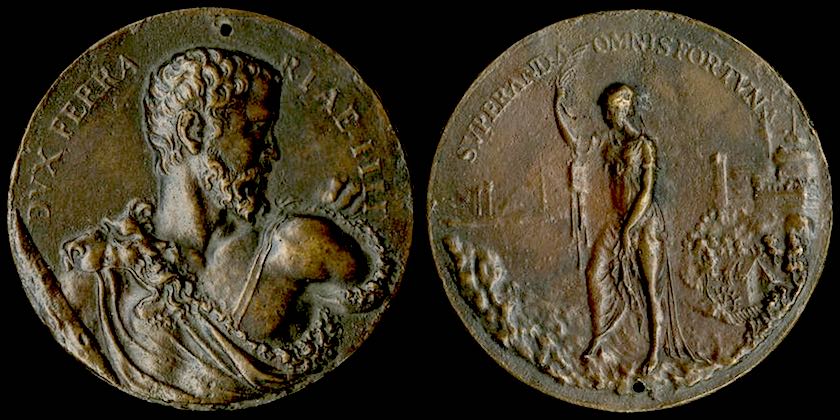
Cast bronze medal n.d. by Alfonso Ruspagiari. Ø 66 mm, 117,19 g. Attwood (2003) 647a. Specimen in The British Museum, London  . .
Obv.: DVX FERRA - RIAE III Bust right, bearded, wearing a lion skin, with a strap over his left shoulder. To left, a club. Rev.: SVPERANDA OMNIS FORTVNAI "All fate is to be conquered" A woman, veiled and wearing antique drapery, holding in her right hand a palm branch, and with a clock suspended from her right arm, standing in a landscape. In the background, to left distant buildings, and to right a castle with a watermill below surrounded by trees.
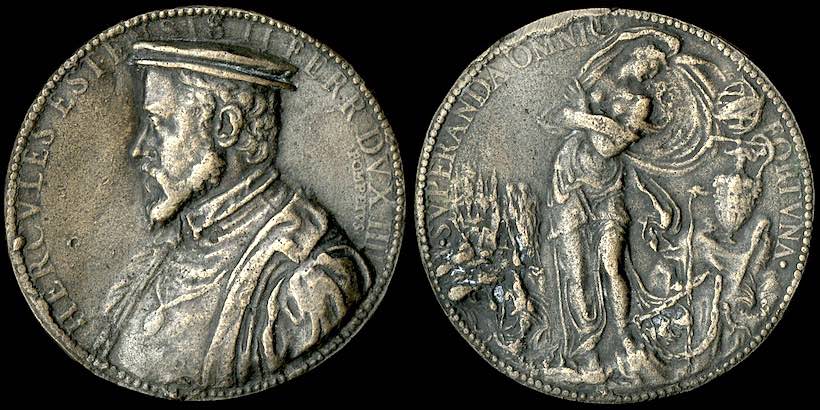
Cast bronze medal 1554 by Pompeo Leoni. Ø 66 mm, 70,67 g. Attwood (2003) 117a. Specimen in The British Museum, London  . .
Obv.: HERCVLES ESTENSIS II FERR DVX IIII - Bust left, bearded, wearing a doublet, a coat, a jewel suspended from a ribbon around his neck and a cap. Signature on the back: ·POMPEIVS· Rev.: SVPERANDA OMNIS - FORTVNA· "All fate is to be overcome" - Patience, draped and veiled, with arms crossed, chained by the left ankle to a rock, on which stands an urn surmounted by an armillary sphere. Liquid from the spout of the urn falls onto the chain. To the left a landscape. |
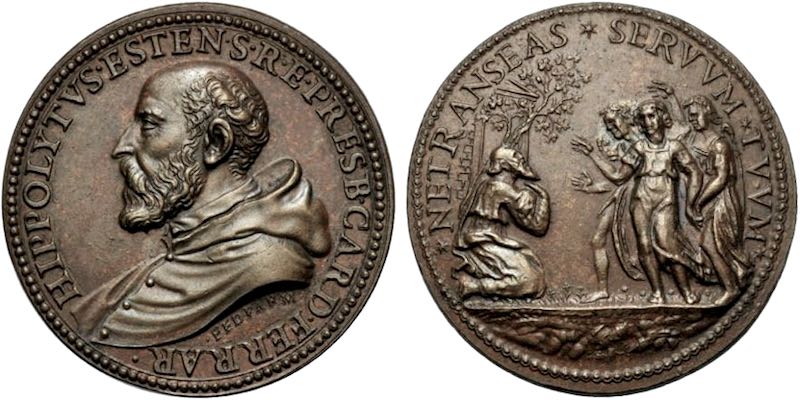
Cast bronze medal by Gian Federigo Bonzagni. Ø 46 mm, 32,2 g. Armand I 222/4; Kress 374 (only obverse); Börner 492; Attwood (2003) 962; Pollard (2007) 429; Toderi-Vannel II 2189. Obv.: HIPPOLYTVS·ESTENsis·Sacrae·Romanae·Ecclesiae·PRESByter·CARDinalis·FERRARiensis· Bust to the left, in cape with hood. Below the signature FEDericus PARMensis Rev.: ⁎NE TRANSEAS⁎SERVVM⁎TVVM⁎ "Pass Not Away From Thy Servant" Abraham kneeling before the three angels/men (Genesis 1). Tree and building behind Abraham. | |
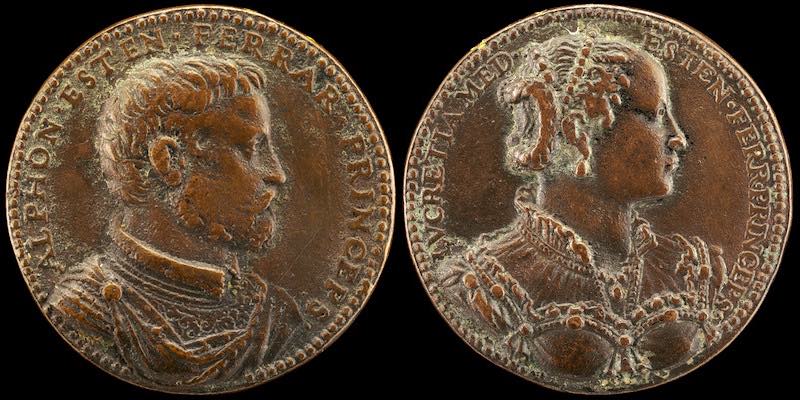
Cast bronze medal (1558) by Domenico Poggini Ø 47,9 mm, 40,02 g. Armand I 260/36; Kress 340; Pollard(2007)388 Specimen in the National Gallery of Art, Washington DC  . .
Obv.: ALPHONsus ESTENsis FERRARiae PRINCEPS - Bust to right of Alfonso. Rev.: LVCRETIA MEDices ESTENsis FERRariae PRINCEPS - Bust to right of Lucrezia. Alfonso married Lucrezia de'Medici (1545-62) in June 1558, a daughter of Duke Cosimo I of Florence.
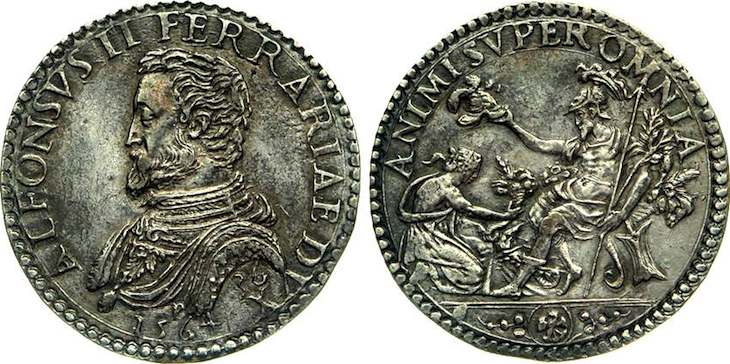
Mezzo scudo 1564, Ferrara. Ø 36 mm, 16,6 g. CNI IX 467/2 tav.31/23; RM 180/4. Obv.: ALFONSVS II FERRARIAE DVX - effigy with draped harness left; below year 1564; at the shoulder P 36 (opus Pastorino & value 36 bolognini). Rev.: ANIMI SVPER OMNIA "especially the feelings" Thrusting and helmeted Mars to the left, lance and palm branch in his left hand, his right hand holds a helmet over the head of a kneeling woman, which gives him a cornucopia. In the exergue: the family coat of arms (eagle) between two branches.
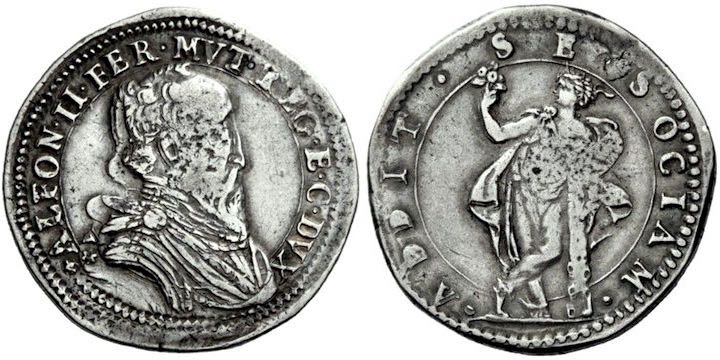
Mezzo scudo n. d., Ferrara. Ø 33 mm, 15,78 g. CNI X 478/93 tv.32/16; RM 181/6; MIR 312/1. Obv.: ALFON II FER MVT REG E C DVX - Bearded bust in armor to the right / double struck. Rev.: ADDIT - SE SOCIAM - Standing woman leaning against a Hercules club, holding a flower. Addit se sociam timidisque supervenit Aegle (Vergil) "Aegle came and joined the timid".
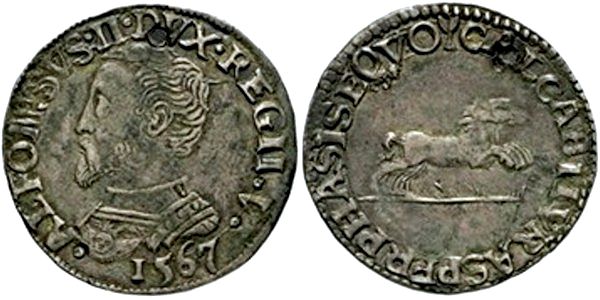
Cavallotto 1567, Reggio. Ø 23 mm, 2,5 g. CNI IX 733/18; RM 190/25. Obv.: ·ALFONSVS·II·DVX·REGII·V· "Alfons II., 5th Duke of Reggio" - Bust left, date at the bottom. Rev.: ⚚CALCABITVR·ASPER·PHASIS·EQVO "the swirling Phases will be crossed on horseback" Several horses jumping to the right.
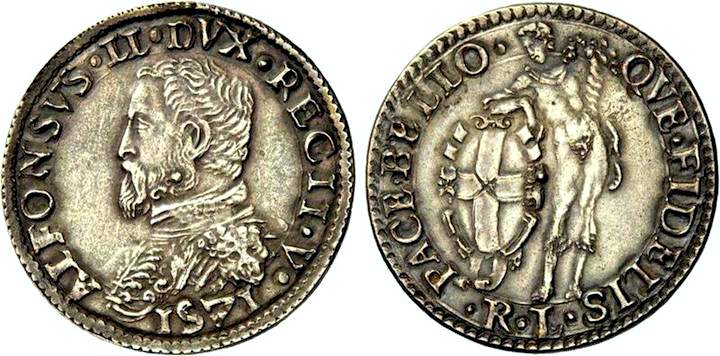
Quarto di scudo 1571, Reggio. Ø 31 mm, 7,17 g. CNI IX 735/34; RM 189/24. Obv.: ALFONSVS·II·DVX·REGII·V· - armed bareheaded effigy left. Rev.: PACE·BELLO· - QVE·FIDELIS· pace belloque fidelis = "faithful in peace and war" (the motto from Reggio). a naked standing man holding cornucopia and city's coat of arms.
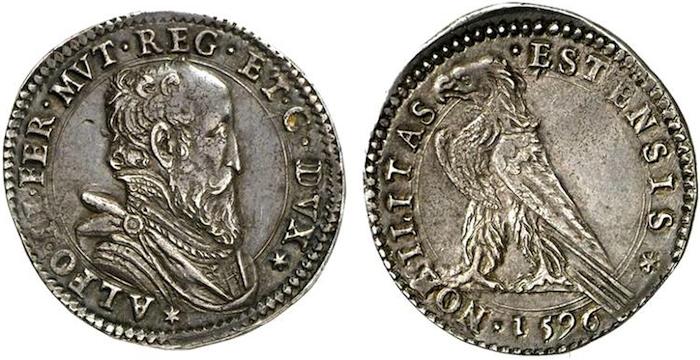
Testone 1596, Ferrara. Ø 28 mm, 8,01 g. CNI X 471/29; RM 183/11. Obv.: * ALFO·II·FER·MVT·REG·ET·C·DVX* C for Carnuntum = Chartres (see above) armored effigy right. Rev.: NOBILITAS - ·ESTENSIS * - 1596 - Symbol of the nobility of Este: eagle, left.
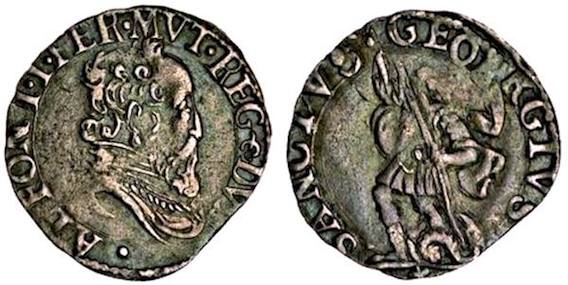
Grossetto n. d., Ferrara. Ø 20 mm, 1,28 g. CNI X 480/113; RM 185/14. Obv.: · ALFON I·I·FER·MVT·REG Є DVX· - effigy right. Rev.: SANCTVS·GEORGIVS - standing St. George stabs his lance into the dragon.
The following ducat of Borso d'Este shows his coat of arms in place of his portrait. 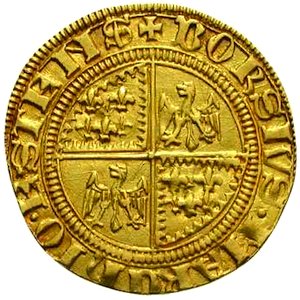
Borso d'Este (1450-1471): obverse of a Ducat, n. d. (1450-52), Ferrara.
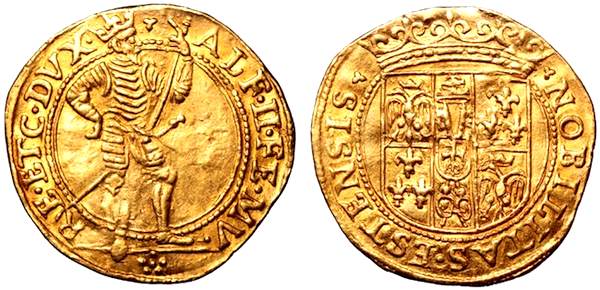
Ongaro (Ducat from the Hungarian type) n. d., Ferrara. Ø 21 mm, 3,44 g. CNI X p.476 n.74; Friedb.273. Obv.: ALF·II·FErrariae·MVtinae· - REgii·ETC·DVX· - full body in armor right, with sword and scepter. Rev.: ·NOBILITAS·ESTENSIS· - crowned arms from Este. |
| The main line of the dynasty extinguished in 1597. The designated heir, Cesare d'Este, whose father was an illegitimate son of Alfonso I, was able to take possession of Modena and Reggio, because emperor Rudolph II recognized him. Ferrara, on the other hand, was taken over by Pope Clement VIII as a settled fief and was incorporated into the Papal States. |
|
Ref: • Corpus Nummorum Italicorum [CNI], vol.X, look at Ferrara - CNI-Index vol. X • Corpus Nummorum Italicorum [CNI], vol.IX, look at Modena and Reggio - CNI-Index vol. IX • Ravegnani Morosini, Mario [RM]: Signorie e Principati. Monete italiane con ritratto 1450-1796. 1984 House of Este in Ferrara, Modena and Reggio: vol.I, p.120 ff. • Armand, Alfred: Les Médailleurs Italiens des quinzième et Seizièmme siècles. Vol.1, Paris 1883 • Kress: Renaissance Medals from the Samuel H.Kress Collection at the National Gallery of Art. London 1967 |
|
Back to Part 1
Niccolò III d'Este, reigned 1393-1441 Leonello d'Este, reigned 1441-1450 Borso d'Este, reigned 1450-1471 Ercole (Hercules) I d'Este, reigned 1471-1505 Ercole's daughter : Isabella d'Este (1474-1539) Back to Part 2 Alfonso I d'Este, reigned 1505-1534 Alfonso's I second wife: Lucrezia Borgia (1480-1519) |
 start page
start page

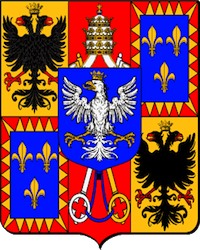 • In 1431 Niccolò III (1393-1441) received the 'Three golden lily
• In 1431 Niccolò III (1393-1441) received the 'Three golden lily